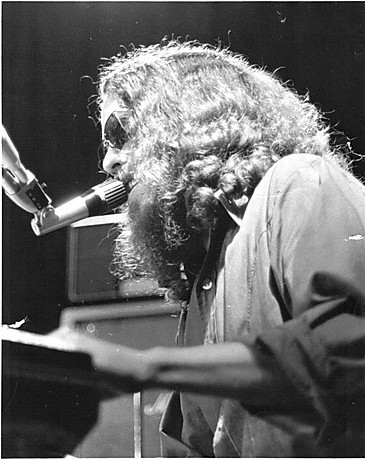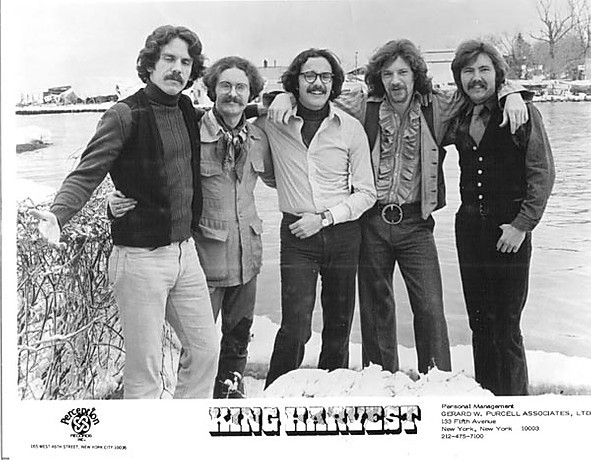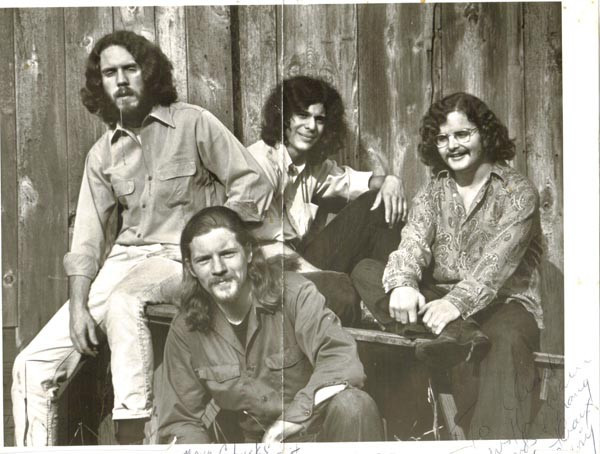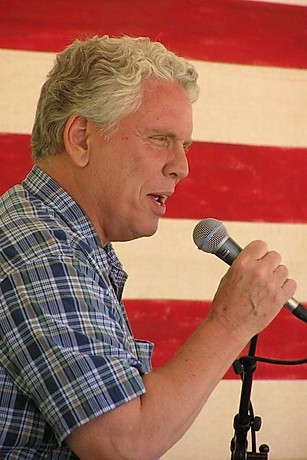“Dancing in the Moonlight” is a song that radiates pure joy and carefree celebration. Its catchy melody and feel-good vibe have made it a beloved classic for decades, covered by various artists and featured in movies and video games. But behind the seemingly simple and uplifting lyrics to “Dancing in the Moonlight” lies a story of unexpected darkness and resilience. This is the tale of how a traumatic experience inspired one of the most enduringly optimistic songs of the 1970s.
The song’s writer, Sherman Kelly, never initially envisioned the massive success “Dancing in the Moonlight” would achieve. In the late 1960s, Kelly was running a nightclub in St. Thomas, Virgin Islands. An ill-fated day trip to St. Croix in 1969 would dramatically alter his life and inadvertently give birth to the iconic lyrics.

Sherman Kelly performing on stage in the 1970s, the era when “Dancing in the Moonlight” lyrics resonated with audiences.
Kelly, along with his girlfriend and friends, chartered a yacht for a day of leisure in St. Croix. However, the journey took a turn for the worse when Kelly and his girlfriend succumbed to severe seasickness. Upon reaching St. Croix, while their companions sought dinner, Kelly and his girlfriend were too unwell to eat and decided to stay behind as the others returned to the yacht for the night. Unfortunately, Kelly realized he had left his wallet on the boat, leaving them stranded without funds for accommodation.
Seeking shelter, they approached a local innkeeper, explaining their predicament and promising to settle the bill the next morning. The innkeeper’s shocking proposition – demanding Kelly’s girlfriend sleep with him in exchange for a room – forced them to seek alternatives. Rejected by a second inn, they were left with no choice but to spend the night outdoors. Kelly’s girlfriend suggested, “It’s a beautiful night. Why don’t we just stretch out on the beach?”
“So we did,” Kelly recounted, his memory of the night becoming fragmented after this point. What followed was a horrific ordeal pieced together from Kelly’s hazy recollections and accounts from others. While sleeping on the beach, they became victims of a brutal attack by the notorious Fountain Valley Gang of St. Croix. Kelly was viciously beaten with baseball bats by five gang members, while his girlfriend was assaulted. In a moment of desperate resilience, Kelly regained consciousness and fought back, his resistance and outcry startling the attackers and causing them to flee.
Badly injured and disoriented, Kelly and his girlfriend managed to find their way to the island’s hospital. Unbeknownst to them at the time, they were likely among the early victims of the Fountain Valley Gang, who would later gain infamy for a mass murder of tourists in 1972, an event that devastated St. Croix’s tourism industry for years.
Kelly’s condition was critical. He vividly recalled waking up in the hospital to the grim prognosis delivered by doctors discussing his and his roommate’s chances of survival. Despite the bleak outlook, Kelly defied expectations and survived. After several days in the St. Croix hospital, he returned to St. Thomas to recover before eventually heading back to New York. There, doctors at New York Hospital undertook the painful process of re-breaking and resetting the bones in his face, along with addressing his other injuries.
Returning to his home in Ithaca, New York, Kelly faced a long and arduous recovery, battling constant pain and headaches. While physically unable to perform with a band, his creative spirit remained undimmed. It was during this period of convalescence, grappling with the trauma he had endured, that the seeds of “Dancing in the Moonlight” lyrics began to sprout.
“I envisioned an alternate reality, the dream of a peaceful and joyous celebration of life. It was just me imagining a better world than the one I had just experienced in St. Croix,” Kelly explained. The lyrics to “Dancing in the Moonlight” became an escape, a fantasy of joy and serenity born from the ashes of violence and fear. An unspeakably traumatic event had become the unlikely catalyst for a song that would bring happiness to millions.
“It was amazing. People liked the song right from the start. I liked it, but I wouldn’t have predicted that it would become a big hit,” Kelly admitted. The song’s journey to becoming a hit, however, was not straightforward.

King Harvest in 1972, the band that propelled “Dancing in the Moonlight” lyrics to national recognition.
Initially, “Dancing in the Moonlight” wasn’t recorded by King Harvest. In 1970, Kelly joined Boffalongo, a band featuring his brother Wells Kelly and future Orleans member Larry Hoppen. Boffalongo recorded “Dancing in the Moonlight” for their 1970 album “Beyond Your Head.” While this version, with Sherman Kelly on lead vocals, became a regional hit, Kelly himself is highly critical of his vocal performance, citing a negative experience with drug use in the studio that marred the recording process.
Despite Kelly’s reservations, the Boffalongo version gained traction. Another group, High Broom, also recorded the song in 1970, but their version failed to chart. When Boffalongo disbanded, Wells Kelly joined King Harvest, a band that also included Doc Robinson, another former member of Boffalongo. It was Wells who introduced “Dancing in the Moonlight” to King Harvest.
King Harvest’s rendition of “Dancing in the Moonlight,” featuring Robinson on lead vocals, was released as a single in 1972. This version became the breakthrough, soaring up the charts and peaking at No. 13 on the Billboard Hot 100. The lyrics to “Dancing in the Moonlight” were suddenly on everyone’s lips, and the song became a defining tune of the summer of 1972.
In the wake of the song’s success, King Harvest invited Sherman Kelly to tour with them. During live performances, Robinson handled the lead vocals, while Sherman Kelly contributed harmonies. Despite enjoying the initial thrill of touring and witnessing his song’s popularity firsthand, Kelly found the realities of life on the road unappealing and left after just one tour. He humorously recalls a critic’s comment: “As a singer, Sherman Kelly is not too bad of a songwriter,” acknowledging his strengths lay more in songwriting than performance.
Wells Kelly later joined forces with John Hall and Larry Hoppen to form Orleans. Orleans also recorded their own version of “Dancing in the Moonlight,” further cementing the song’s status as a classic. Even today, Orleans, still featuring John Hall and Larry Hoppen’s brothers, Lance and Lane Hoppen, continues to include “Dancing in the Moonlight” in their live sets, a testament to its enduring appeal. Larry Hoppen passed away in 2012, but his musical legacy, intertwined with the story of this iconic song, lives on.

Boffalongo, circa 1970, the first band to record “Dancing in the Moonlight” lyrics, featuring Sherman Kelly (unpictured).
Sherman Kelly’s life took diverse paths beyond music after the initial success of “Dancing in the Moonlight.” A graduate of Cornell University with degrees in psychology and English, he pursued further studies in Paris, Switzerland, and New York City. Following the tragic death of his brother Wells in 1984, Sherman Kelly stepped away from the music industry and dedicated himself to a career in psychotherapy, earning a master’s degree in social work. He worked as a psychotherapist for many years until his retirement.
Despite leaving the limelight, Kelly returned to music in 2008 with the album “Burnin’ the Candle,” featuring songs he had co-written with his brother Wells. The enduring power of “Dancing in the Moonlight” was reaffirmed in 2000 when Toploader’s cover version became another hit, introducing the song to a new generation. The song has also graced numerous films and TV shows, and even featured in the “Guardians of the Galaxy” video game, ensuring its continued relevance.

Sherman Kelly today, the songwriter behind the timeless lyrics to “Dancing in the Moonlight”.
From its dark and traumatic origins to its global recognition and enduring popularity, the story behind the lyrics to “Dancing in the Moonlight” is a fascinating testament to the power of music to transform personal pain into universal joy. Sherman Kelly’s ability to envision “a better world” amidst personal tragedy resulted in a song that continues to uplift and resonate with listeners across generations, proving that even from the darkest night, a song of light can emerge.

